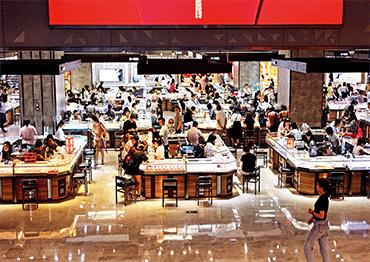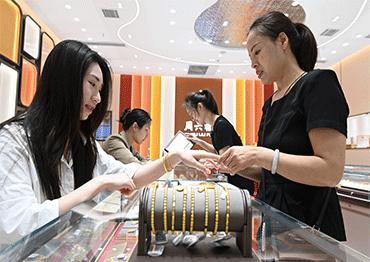Rapid expansion of jewelry brands and quality complaints are tarnishing gold retail. But product innovation and younger consumers seeking safe-haven investments could help regain its shine, experts say
Several months after the sudden closure of a Beijing franchise gold outlet, State-owned China National Gold Jewelry (China Gold) announced on April 1 that it will compensate customers who had bought and deposited gold there.
More than 50 customers of the China Gold location were shocked when the store closed in December 2023 and were unable to withdraw their gold bars valued at around US$5.5 million on the spot market.
China Gold initially refused to take responsibility following the closure of the store, which opened at Beijing R&F Plaza in 2009, as the company forbids franchisees from providing gold custody services.
Interviewed customers said they were unaware that China Gold is a franchise and the vast majority of stores are operated independently. By 2022, less than 3 percent of its 3,642 outlets in China were directly operated by the company, according to China Gold’s 2022 annual report.
Franchising has become a significant way for large Chinese jewelry retailers like China Gold to expand their market share. This trend has quickened as domestic demand for gold as a safe-haven asset surges amid increasing economic and geopolitical uncertainties.
Expansion has been particularly rapid in China’s smaller cities. As of June 2023, 71.88 percent of major jewelry retailer Chow Tai Seng’s franchise outlets are in third-tier cities and smaller.
The increasingly crowded market is shrinking profit margins. “Opening a gold store is not as lucrative as it was, though you won’t be stony broke,” Gu Yao, who owns a number of gold franchise outlets in Ningbo, Zhejiang Province, told NewsChina.
Retail gold jewelry prices in China soard in April, reaching over 700 yuan (US$97) per gram, which further drove many potential consumers away from gold purchases. Compounded with rising customer complaints over quality and management of franchises, theretail gold market in China is struggling.

The eight-story Hubei flagship store of China Gold, Wuhan, August 2023 (Photo by VCG)
Boom Towns
Gu Yao, who owns a Hong Kongbased jewelry brand’s franchise outlet in a Ningbo shopping mall, said she has seen more younger customers this year. The youngest one was a second grader who came in weekly with her mother to buy gold nuggets. In February during Chinese New Year, Gu said sales doubled over the previous month.
Despite soaring prices, buying gold is still an attractive store of wealth. In 2023, gold consumption in China totaled 1,089.69 tons, a rise of 8.78 percent over the previous year, among which the consumption of gold bars and gold coins grew 15.7 percent yearon-year, according to the China Gold Association.
Increasing geopolitical and economic risks underscore the advantage of gold jewelry as a long-term investment, noted Xu Ying, chief analyst with Orient Futures.
The increased demand is driving jewelers to open more stores. In Quzhou, Zhejiang Province, 15 gold stores are crammed onto a single 200-meter-long street, most of which opened in the last three years.
Gu Yao said that there are 18 other gold outlets in the same shopping mall as her store. “It’s very common for outlets to congregate in one area,” she said.
Major cities were once the focus of major gold dealers. By September 2023, Hong Kong-based Chow Tai Fook had opened 900 stores in first-tier cities and 3,600 in second-tier cities. But as their markets saturated, expansion into smaller cities grew. Chow Tai Seng opened 215 stores in the first nine months of 2023, an average of five new stores per week. By the end of September 2023, it had 4,831 outlets, among which nearly 70 percent are in third-tier cities and smaller.
Gu told NewsChina that for big brands, business is better in smaller cities and counties, where people usually buy multiple pieces of gold jewelry to mark important events such as childbirth, job promotions and marriage. In less-developed regions, bride prices paid by the bridegroom before marriage sometimes require up to six gold items, Gu said.
Between 2017 and 2022, the consumer market for gold in China surged from 102.4 billion yuan (US$14.1b) to 174.2 billion yuan (US$24.1b), according to a Frost&Sullivan report.
In Chains
Entering a franchise is a less costly way of increasing market share, as independent retail stores require huge upfront investment. As profit margins for gold sales are slim, companies can boost income by charging their franchisees for brand royalties and management services.
In 2022, China Gold’s revenue from franchise stores reached 18.321 billion yuan (US$2.5b), accounting for 39.1 percent of its total income, while its gross profit margin from franchises was 6.03 percent higher than the 2.46 percent profit margin from direct sales.
Gu said that this round of expansion started when Chow Tai Fook opened franchises in smaller cities in 2018, a focus shift that followed the launch of China’s urbanization construction plan.
Between 2020 and 2023, the number of its outlets jumped from 3,984 to 7,655.
Lao Feng Xiang, another major gold brand, also realized the importance of expanding to smaller cities in 2018. By the end of 2022, it had 5,609 retail outlets, 96 percent of which are franchises.
By the end of 2022, Chow Tai Seng’s franchise outlets accounted for 94.6 percent of its total stores. For the majority of big brands in China, independentlyoperated franchises account for over 90 percent of their total outlets.
But this growing number is causing a management dilemma, as complaints over product quality are on the rise – especially in smaller cities. Over 5,000 complaints have been registered against China Gold, according to customer service platform Heimao Tousu. In a post on the site from April 11, one consumer wrote that he bought two items of gold jewelry from a China Gold outlet in Heze, Shandong Province that do not match their quality documentation. There are also numerous complaints on the platform against other brands such as Chow Tai Fook and Chow Tai Seng over issues like underweight items, pricing and craftsmanship problems. Gu told NewsChina that her family has been involved in the gold trade for over 20 years. They operate more than 10 shops in Ningbo and nearby county towns, most of which are franchises. She said that gold brands expanded most rapidly during the Covid pandemic, and Hong Kong-based franchises like Chow Tai Fook have greater market appeal.
Competition kicked off with local entrepreneurs scrambling for franchise rights, many of which went to familyowned businesses previously engaged in jewelry. It is common for one family to own dozens of franchises in any given city, Gu said.
The threshold for opening a gold franchise in a second-tier city is at least 6 million yuan (US$829,000). In addition to store front rent in a prime location, the largest investment goes to buying gold from franchisors, which usually set a minimum purchase amount. Gu said she was required to buy at least 10 kilograms of gold products.
Franchisees are often pressured into buying larger amounts of gold under threat of the chain allowing another store to open in the area, NewsChina learned.

Customers inspect wares at Shenzhen Shuibei Jewelry Trading Center, Shenzhen, Guangdong Province (Photo by VCG)

A customer tries on a bracelet at a gold shop in Sunac Mall, Shapingba District, Chongqing, April 12, 2024 (Photo by VCG)
Keeping Up with the Smiths
The growing market and rising gold prices have also added shine to goldsmithing and custom pieces. Wan Xipeng, who owns a workshop in Shenyang, Liaoning Province, regularly has two weeks of back orders with customers coming in daily.
Some younger customers seek him out directly after buying gold bars from banks, where gold is often available for up to 100 yuan (US$13.8) cheaper per gram than in retail jewelry stores.
Goldsmiths charge an average 10 yuan per gram for their work, much lower than retail stores. Many customers drive hundreds of kilometers from neighboring cities for Wan’s services for the savings.
Wan first opened a shop in his hometown in Inner Mongolia Autonomous Region in the summer of 2019. He quickly found the greatest challenge was winning consumer trust. Just after opening a new shop in Shenyang, the pandemic began. Wan filled the downtime by creating goldsmithing videos on social media platforms to attract customers. Soon orders flooded in, with customers placing orders online and shipping him raw gold to craft.
After the pandemic, his store front reopened and business kept booming. Wan moved to a larger workshop and purchased new machinery. In March 2023, he also brought on two goldsmiths. The shop is still unable to meet demand.
Wan Xipeng noticed that the number of local goldsmiths have increased over the past year. “In Shenyang alone, the number of people engaged in the business has at least tripled since the pandemic,” Wan said.
Wang Dachui, a craftsman from Meishan, Sichuan Province, just entered the trade this year. But he is already feeling the pressure.
His interest in gold was first piqued while shopping for jewelry for his marriage. He eventually traveled to Shen zhen, Guangdong Province to study goldsmithing. When he returned home about six months later, someone had already opened shop nearby. He told NewsChina that in the first month, there were just as many inquiries about goldsmithing as gold customers. “At least 40 people showed up and asked where I learned the skill. Some even wanted to learn from me,” Wang said.
All That Glitters
But the gold business is not always a solid investment. The gross profit rate of Chow Tai Fook was 22.63 percent in 2023, a nine-year low. Mokingran, a jewelry brand based in Tianjin currently seeking an IPO in Hong Kong, recorded a gross profit margin of only 5.7 percent in the first half of 2023. By Q3 2023, the gross profit margin was only 4.23 percent.
The price of gold is determined by a variety of factors, such as international gold prices, geopolitics, inflation and the interest rates of the US dollar. Since the gold price is rather transparent, retail profit margins of gold jewelry are much lower than that of other precious metals and stones, including diamonds.
According to Mokingran’s prospectus, their gold-based product line is behind their low profits. In the first half of 2023, 98.1 percent of its income was from pure gold jewelry, which yielded a 4.9 percent gross profit margin, while less than 2 percent was from gold alloys (mixed with silver, zinc or copper) and diamond jewelry, the gross profit margin of which is 25.6 percent.
The rapid expansion of franchises further dilutes profits as gold products were sold to franchisees wholesale. Chow Tai Fook revealed in its half-year results for 2023 that its gross profit margin dipped from 23.5 percent to 22.4 percent year-on-year, a record low. Its wholesale business and increased proportion of gold jewelry and products were cited as the main reasons.
The same goes for franchisees. Despite demand for gold products, “sales for the first two months of 2024 were basically on par with the same period last year” because of the higher gold prices this year, Gu Yao said. She added that sales of low-profit solid gold products are higher this year, which contributes little in profits. Besides, as gold prices rise, her costs rise too.
Opening gold stores is becoming less lucrative as more players join the arena. Wu Yan operates two franchise stores in a county of Sichuan Province with a population of 400,000. There are 13 gold stores on his street alone, three of which opened this year.
Gu Yao told NewsChina that business is particularly more difficult in smaller cities where consumers prefer gold because of its higher cost-performance ratio instead of designed jewelry, which is sold at a premium. She explained that consumers in counties are more sensitive to price and usually shop around, leading to cutthroat price wars.
Many younger consumers turn to smaller stores, most of which source their gold from Shenzhen’s Shuibei area, the country’s largest wholesale and retail jewelry hub. Many gold processing factories and wholesalers who previously sold to shops are now selling directly to consumers online, usually at more competitive prices.
In addition, customers are increasingly opting for simpler or traditional designs, as they are more cost-effective products with lower smithing fees, an important source of income for gold shops. Zhu Li, a gold franchise owner in Zibo, Shandong Province, told news outlet Time Finance that she sold more lightweight and lower-priced products this year.
Wu Yan tol77his second outlet has not turned a profit, he plans to cut his losses and close shop.
Dong Fu, a goldsmith from Inner Mongolia Autonomous Region, said the gold stores that line the main street of his county town are entrenched in price wars to vie for customers.
The competition has spilled over to goldsmiths. “The fall in label or retail prices means a decrease in smithing fees,” Dong Fu said, “But greater pressure comes from other workshops that sometimes attract customers by cutting prices. Such vicious competition is not good for anyone.”
In a December 2023 interview with Jewelry Magazine, Wang Lixin, CEO of the World Gold Council (China), emphasized the need for greater focus on innovations in craftsmanship, such as more resilient alloys that can facilitate intricate designs to appeal to younger consumers.
This approach would “produce products of higher added value that allow more room for charging processing fees,” Wang said.
Big jewelry retailers are already slowing their expansion. Chow Tai Fook said in its fiscal report that it had already achieved its goal of opening 7,000 chain stores by 2025, and will focus on highquality expansion, performance of retail outlets and customer experience.
China Gold also started to contract its scale before the abrupt closure of its Beijing store. In 2022, China Gold saw a net decrease of 85 stores.
While the steady rise in gold prices increases the appeal of gold to investors, many consumers remain hesitant to buy or have even given up on planned purchases, several gold store owners told NewsChina.
The demand for gold bars and coins will stay robust in 2024, but high gold prices and potential economic slowdown might hold back gold consumption, which will be further dragged by sliding marriage rates, the World Gold Council analyzed in a report published in January.

 Old Version
Old Version


